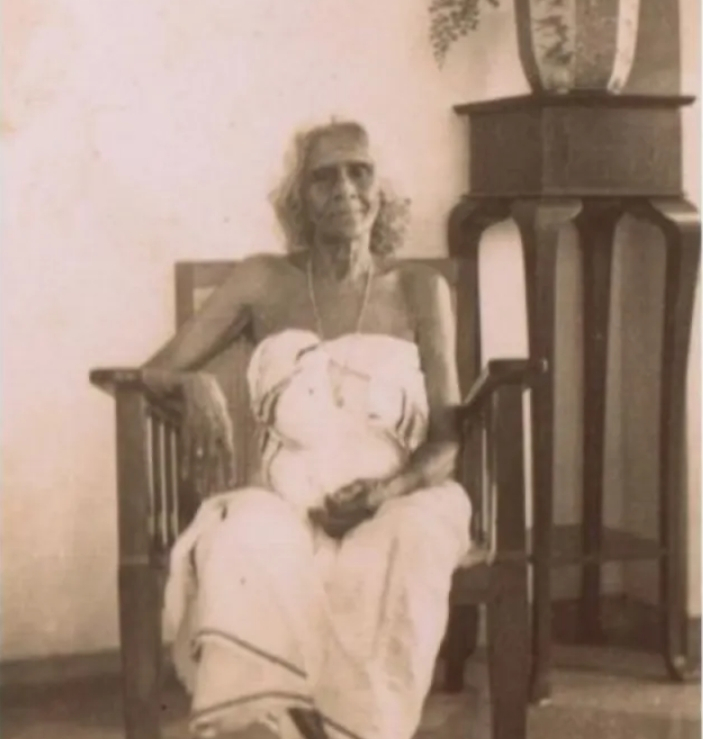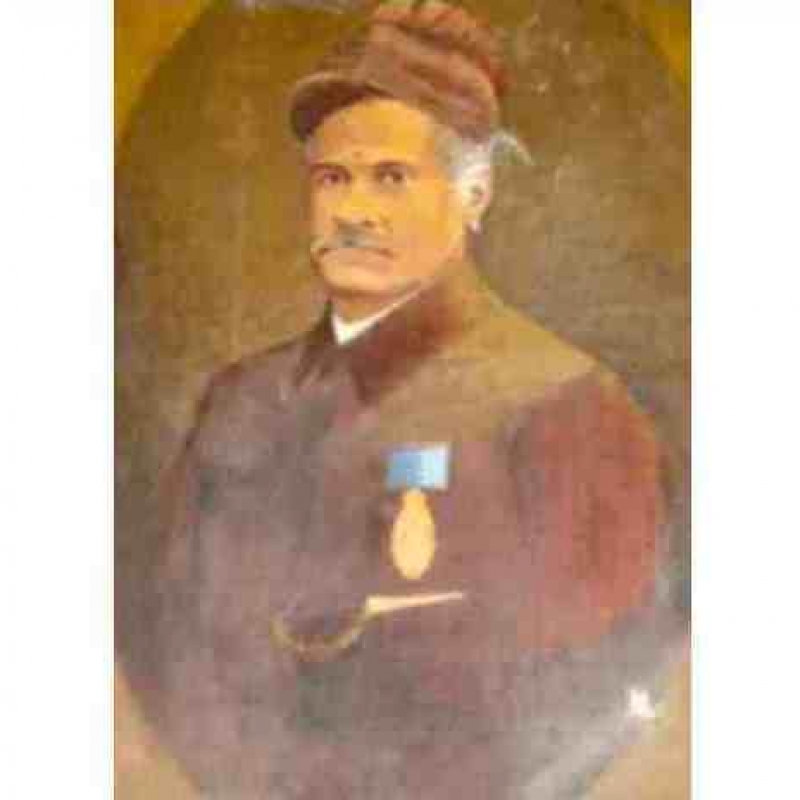While the world knows about Raja Ravi Varma and his contribution to modern Indian commercial art, not many know that even his younger brother and assistant, C. Raja Raja Varma, was regarded as one of the ‘the foremost painters of 19-century India’. Not only that, his sister Mangalabai Thampuratty was the first Indian woman to work in an artist’s studio. We train the spotlight on the Varma siblings. (In pic: Raja Ravi Varma portrait by Mangala Bayi; Photo courtesy: vc.bridgew.edu)
In 1888, at Ooty, Raja Ravi Varma met the Gaekwad of Baroda and secured a commission of 14 Puranic paintings for the Durbar Hall of the new Lakshmi Vilas Palace at Baroda.[1] Tapati Guha-Thakurta has described this as the ‘most serious of commissions’, one that ‘required, above all, a more thorough testing of the authenticity and “Indian-ness” of the images and personages he used in his mythological illustrations.’ In this significant venture, he was assisted by his sister, Mangalabai Thampuratty, and his brother, C. Raja Raja Varma, as they toiled for over a year in their Kilimanoor home on these paintings.[2] What ultimately emerged was a set of 14 illustrations: all either adventures of Krishna from the Bhagavata Purana or events from the Ramayana and Mahabharata.[3]
Also read | Indian Art Criticism: Its Past and Present
Until his death in 1906, Ravi Varma was arguably the most celebrated and successful artist India had ever known. Scattered over the princely states and temple towns of southern India, Ravi Varma lived his life in the changing world of court and bazaar artists, as alien tastes and aesthetic standards transformed the terrain of artistic experience in India.[4] Often, he would adapt his style from court to court to meet the taste and preferences of his patrons.[5] And, in the execution of these commissions, he functioned as the head of a studio that employed assistants.[6] Chief among them was his brother, C. Raja Raja Varma.[7]

Sibling Camaraderie
Perhaps India’s first landscape artist, Raja Raja Varma’s paintings reflected his keen eye for the natural world around him. Like his brother, he also painted numerous studies of women against romanticised backdrops of work or leisure.[8] He accompanied Ravi Varma on his ‘tour of discovery’ of India between 1888–89; they visited royal courts, and recorded—in vivid detail—their winding travels in search of patronage.[9] Raja Raja Varma’s diary remains one of the most important sources we have on the latter part of Ravi Varma’s life. His most important association with Ravi Varma’s work, however, was in painting the backdrops and landscapes of his Puranic paintings. The Baroda commission of 1881 is an important example of this collaboration.[10] Later, in Bombay, they set up a modern studio where they produced some of the finest portraits of leading European and Indian personalities—including the famous portraits of Dadabhai Naroji and Bal Gangadhar Tilak. In 1894, together they also launched the Ravi Varma Fine Art Lithographic Press to oleograph the paintings of epic and Puranic stories; bringing religious icons to the homes of the poor and the middle-class Indian. Oxford-based historian Parthha Mitter said that the Varma brothers were among ‘the foremost painters of 19-century India’.[11] Despite these achievements, Raja Raja Varma has remained, however, in the long shadow of his more illustrious brother.

The Artist Princess
The Varma brothers worked with other artists as a unit in the age-old workshop tradition of master and apprentices.[12] Ravi Varma’s success as a painter of Indian traditions was, therefore, not only an individual but a joint accomplishment. Guha-Thakurta says, ‘This formula for success was seen by him and his fellow painters less as an exclusive product of individual talent, than as a skill and craft that could be acquired and honed to perfection and passed on to subsequent generations.’[13] Their sister, Mangalabai Thampuratty, also worked under the informal tutelage of the family artists as an oil painter, learning by observing her brothers. She is the first Indian woman in the nineteenth century to work out of a studio. After all being the princess of Kilimanoor does have its perks, even if she couldn’t take up painting as a profession since that was a taboo for noblewomen.
Also see | Art for All: Street Art at Lodhi Colony
‘Charity’, a painting of a woman giving alms to a mendicant, a portrait of Mahatma Gandhi and ‘Ravi Varma: my lamented brother’, a posthumous portrait of Raja Ravi Varma, are her only known works.[14] There is a story about how occasionally Ravi Varma sought Mangalabai’s opinion on his paintings, and once even made changes to one based on her suggestion. As Lakshmi Priya Daniel says, ‘Mangala Bai, in all probability, lacked the opportunity to explore all the possibilities of her potential, but within her limitations produced commendable works which show her continued allegiance to Ravi Varma’s style of realism, combined with the same interest in portraiture, mythology and epic.’[15]

Aside from her, Ravi Varma’s son, Rama Varma, and nephew, K.R. Ravi Varma, were other family members who acquired formal training in art. It is this informal group of family artists that grew around Varma that was later referred to as the ‘Kilimanoor School’ of painting.[16]
Of the group, however, it was Raja Raja Varma who remained a life-long assistant, collaborator, and partner to the genius of his brother; adding lifelike touches to the landscapes of Ravi Varma paintings. Rupika Chawla, an art conservator and author of Raja Ravi Varma: Painter of Colonial India, has perhaps rightly suggested that it was the contemporary norms of appropriacy that kept Raja Raja Varma from recording, even in his diary, the full extent of his contributions to the paintings of Indian epics and mythology.[17] While painting is not commonly a family enterprise, Ravi Varma’s career resembles less of an individual artist than that of an artistic enterprise, opines Rupika Chawla.[18]
Their legacy, as they stood between the ending chapters of Indian court painting and the beginning pages of modern art in India, lies in the way they leveraged their unique location in a period of transition—building an expansive network of patrons and clients and achieving hitherto unknown professional and commercial successes in the world of Indian art.
This article was also published on Scroll.in.
Notes
[1] Tapati Guha Thakurta,’Westernisation and Tradition in South Indian Painting in the Nineteenth Century: The Case of Raja Ravi Varma (1848-1906),’ Studies in History 2, no. 2 (August 1986), 165–95. doi:10.1177/025764308600200203.
[2] Ibid.
[3] Ibid.
[4] Ibid.
[5] R. Siva Kumar, ‘Ravi Varma: art as enterprise in colonial India’, The Hindu, May 9, 2010. Accessed July 15, 2020,
[6] Ibid.
[7] Ibid.
[8] Tapati Guha Thakurta,’Westernisation and Tradition in South Indian Painting in the Nineteenth Century: The Case of Raja Ravi Varma (1848-1906),’ Studies in History 2, no. 2 (August 1986), 165–95. doi:10.1177/025764308600200203.
[9] Ibid.
[10] Ibid.
[11] TNN, ‘A webinar on the influence of Renaissance on Kerala Art’, The Times of India, July 8, 2020. Accessed July 16, 2020. https://timesofindia.indiatimes.com/entertainment/events/bangalore/a-webinar-on-the-influence-of-renaissance-on-kerala-art/articleshow/76855779.cms.
[12] Tapati Guha Thakurta,’Westernisation and Tradition in South Indian Painting in the Nineteenth Century: The Case of Raja Ravi Varma (1848-1906),’ Studies in History 2, no. 2 (August 1986), 165–95. doi:10.1177/025764308600200203.
[13] Ibid.
[14] Ibid.
[15] Lakshmi Priya Daniel, ‘Signatures of a Collective Self: A Study of Select Contemporary Women Artists from South India’, Journal of International Women's Studies 18, no. 1 (2016).
[16] Tapati Guha Thakurta, ‘Westernisation and Tradition in South Indian Painting in the Nineteenth Century: The Case of Raja Ravi Varma (1848-1906),’ Studies in History 2, no. 2 (August 1986), 165–95. doi:10.1177/025764308600200203.
[17] R. Siva Kumar, ‘Ravi Varma: art as enterprise in colonial India’, The Hindu, May 9, 2010. Accessed July 15, 2020,
[18] Ibid.













